Zixing Zhang
OneRec-V2 Technical Report
Aug 28, 2025Abstract:Recent breakthroughs in generative AI have transformed recommender systems through end-to-end generation. OneRec reformulates recommendation as an autoregressive generation task, achieving high Model FLOPs Utilization. While OneRec-V1 has shown significant empirical success in real-world deployment, two critical challenges hinder its scalability and performance: (1) inefficient computational allocation where 97.66% of resources are consumed by sequence encoding rather than generation, and (2) limitations in reinforcement learning relying solely on reward models. To address these challenges, we propose OneRec-V2, featuring: (1) Lazy Decoder-Only Architecture: Eliminates encoder bottlenecks, reducing total computation by 94% and training resources by 90%, enabling successful scaling to 8B parameters. (2) Preference Alignment with Real-World User Interactions: Incorporates Duration-Aware Reward Shaping and Adaptive Ratio Clipping to better align with user preferences using real-world feedback. Extensive A/B tests on Kuaishou demonstrate OneRec-V2's effectiveness, improving App Stay Time by 0.467%/0.741% while balancing multi-objective recommendations. This work advances generative recommendation scalability and alignment with real-world feedback, representing a step forward in the development of end-to-end recommender systems.
Kwai Keye-VL Technical Report
Jul 02, 2025Abstract:While Multimodal Large Language Models (MLLMs) demonstrate remarkable capabilities on static images, they often fall short in comprehending dynamic, information-dense short-form videos, a dominant medium in today's digital landscape. To bridge this gap, we introduce \textbf{Kwai Keye-VL}, an 8-billion-parameter multimodal foundation model engineered for leading-edge performance in short-video understanding while maintaining robust general-purpose vision-language abilities. The development of Keye-VL rests on two core pillars: a massive, high-quality dataset exceeding 600 billion tokens with a strong emphasis on video, and an innovative training recipe. This recipe features a four-stage pre-training process for solid vision-language alignment, followed by a meticulous two-phase post-training process. The first post-training stage enhances foundational capabilities like instruction following, while the second phase focuses on stimulating advanced reasoning. In this second phase, a key innovation is our five-mode ``cold-start'' data mixture, which includes ``thinking'', ``non-thinking'', ``auto-think'', ``think with image'', and high-quality video data. This mixture teaches the model to decide when and how to reason. Subsequent reinforcement learning (RL) and alignment steps further enhance these reasoning capabilities and correct abnormal model behaviors, such as repetitive outputs. To validate our approach, we conduct extensive evaluations, showing that Keye-VL achieves state-of-the-art results on public video benchmarks and remains highly competitive on general image-based tasks (Figure 1). Furthermore, we develop and release the \textbf{KC-MMBench}, a new benchmark tailored for real-world short-video scenarios, where Keye-VL shows a significant advantage.
OneRec Technical Report
Jun 16, 2025Abstract:Recommender systems have been widely used in various large-scale user-oriented platforms for many years. However, compared to the rapid developments in the AI community, recommendation systems have not achieved a breakthrough in recent years. For instance, they still rely on a multi-stage cascaded architecture rather than an end-to-end approach, leading to computational fragmentation and optimization inconsistencies, and hindering the effective application of key breakthrough technologies from the AI community in recommendation scenarios. To address these issues, we propose OneRec, which reshapes the recommendation system through an end-to-end generative approach and achieves promising results. Firstly, we have enhanced the computational FLOPs of the current recommendation model by 10 $\times$ and have identified the scaling laws for recommendations within certain boundaries. Secondly, reinforcement learning techniques, previously difficult to apply for optimizing recommendations, show significant potential in this framework. Lastly, through infrastructure optimizations, we have achieved 23.7% and 28.8% Model FLOPs Utilization (MFU) on flagship GPUs during training and inference, respectively, aligning closely with the LLM community. This architecture significantly reduces communication and storage overhead, resulting in operating expense that is only 10.6% of traditional recommendation pipelines. Deployed in Kuaishou/Kuaishou Lite APP, it handles 25% of total queries per second, enhancing overall App Stay Time by 0.54% and 1.24%, respectively. Additionally, we have observed significant increases in metrics such as 7-day Lifetime, which is a crucial indicator of recommendation experience. We also provide practical lessons and insights derived from developing, optimizing, and maintaining a production-scale recommendation system with significant real-world impact.
DEBATE: A Dataset for Disentangling Textual Ambiguity in Mandarin Through Speech
Jun 09, 2025Abstract:Despite extensive research on textual and visual disambiguation, disambiguation through speech (DTS) remains underexplored. This is largely due to the lack of high-quality datasets that pair spoken sentences with richly ambiguous text. To address this gap, we present DEBATE, a unique public Chinese speech-text dataset designed to study how speech cues and patterns-pronunciation, pause, stress and intonation-can help resolve textual ambiguity and reveal a speaker's true intent. DEBATE contains 1,001 carefully selected ambiguous utterances, each recorded by 10 native speakers, capturing diverse linguistic ambiguities and their disambiguation through speech. We detail the data collection pipeline and provide rigorous quality analysis. Additionally, we benchmark three state-of-the-art large speech and audio-language models, illustrating clear and huge performance gaps between machine and human understanding of spoken intent. DEBATE represents the first effort of its kind and offers a foundation for building similar DTS datasets across languages and cultures. The dataset and associated code are available at: https://github.com/SmileHnu/DEBATE.
ProsodyFM: Unsupervised Phrasing and Intonation Control for Intelligible Speech Synthesis
Dec 16, 2024



Abstract:Prosody contains rich information beyond the literal meaning of words, which is crucial for the intelligibility of speech. Current models still fall short in phrasing and intonation; they not only miss or misplace breaks when synthesizing long sentences with complex structures but also produce unnatural intonation. We propose ProsodyFM, a prosody-aware text-to-speech synthesis (TTS) model with a flow-matching (FM) backbone that aims to enhance the phrasing and intonation aspects of prosody. ProsodyFM introduces two key components: a Phrase Break Encoder to capture initial phrase break locations, followed by a Duration Predictor for the flexible adjustment of break durations; and a Terminal Intonation Encoder which integrates a set of intonation shape tokens combined with a novel Pitch Processor for more robust modeling of human-perceived intonation change. ProsodyFM is trained with no explicit prosodic labels and yet can uncover a broad spectrum of break durations and intonation patterns. Experimental results demonstrate that ProsodyFM can effectively improve the phrasing and intonation aspects of prosody, thereby enhancing the overall intelligibility compared to four state-of-the-art (SOTA) models. Out-of-distribution experiments show that this prosody improvement can further bring ProsodyFM superior generalizability for unseen complex sentences and speakers. Our case study intuitively illustrates the powerful and fine-grained controllability of ProsodyFM over phrasing and intonation.
Re-Parameterization of Lightweight Transformer for On-Device Speech Emotion Recognition
Nov 14, 2024
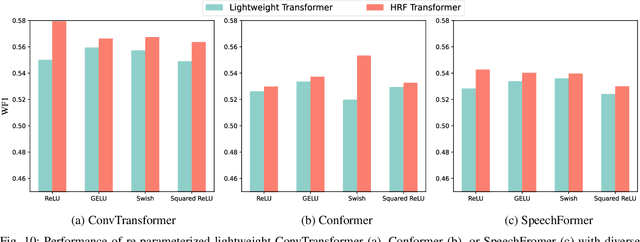
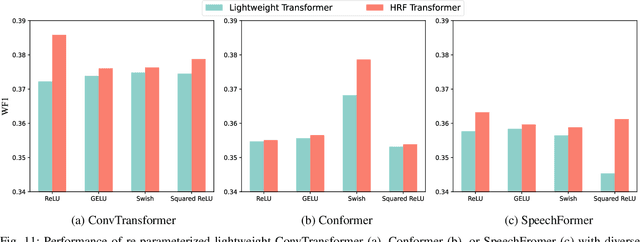
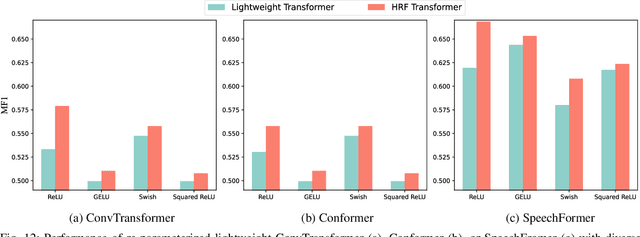
Abstract:With the increasing implementation of machine learning models on edge or Internet-of-Things (IoT) devices, deploying advanced models on resource-constrained IoT devices remains challenging. Transformer models, a currently dominant neural architecture, have achieved great success in broad domains but their complexity hinders its deployment on IoT devices with limited computation capability and storage size. Although many model compression approaches have been explored, they often suffer from notorious performance degradation. To address this issue, we introduce a new method, namely Transformer Re-parameterization, to boost the performance of lightweight Transformer models. It consists of two processes: the High-Rank Factorization (HRF) process in the training stage and the deHigh-Rank Factorization (deHRF) process in the inference stage. In the former process, we insert an additional linear layer before the Feed-Forward Network (FFN) of the lightweight Transformer. It is supposed that the inserted HRF layers can enhance the model learning capability. In the later process, the auxiliary HRF layer will be merged together with the following FFN layer into one linear layer and thus recover the original structure of the lightweight model. To examine the effectiveness of the proposed method, we evaluate it on three widely used Transformer variants, i.e., ConvTransformer, Conformer, and SpeechFormer networks, in the application of speech emotion recognition on the IEMOCAP, M3ED and DAIC-WOZ datasets. Experimental results show that our proposed method consistently improves the performance of lightweight Transformers, even making them comparable to large models. The proposed re-parameterization approach enables advanced Transformer models to be deployed on resource-constrained IoT devices.
ParaLBench: A Large-Scale Benchmark for Computational Paralinguistics over Acoustic Foundation Models
Nov 14, 2024
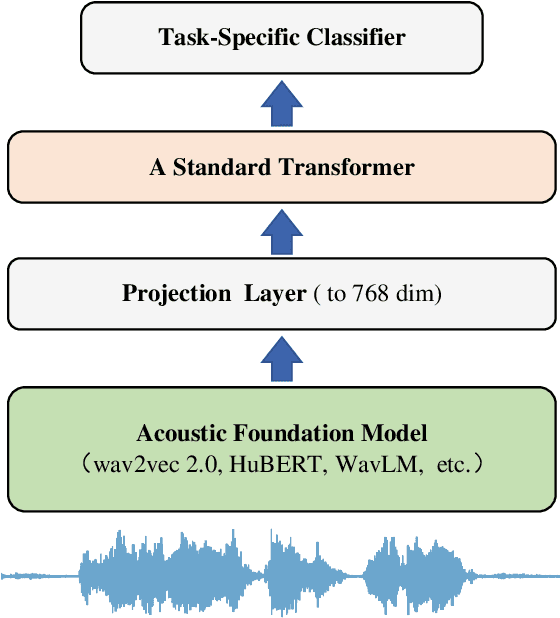
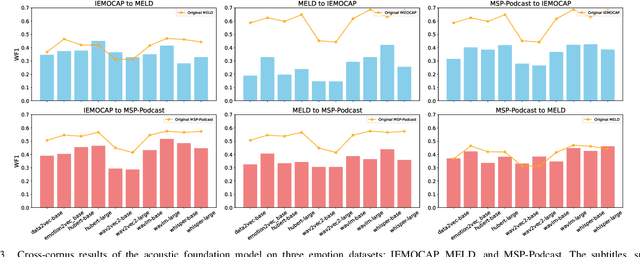
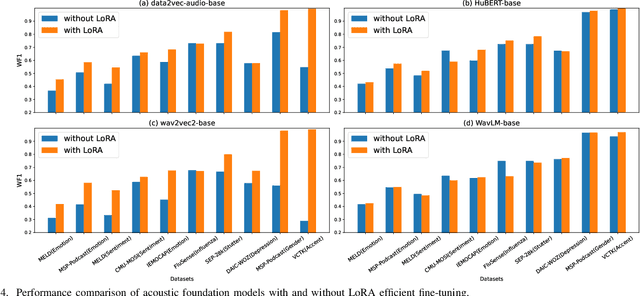
Abstract:Computational paralinguistics (ComParal) aims to develop algorithms and models to automatically detect, analyze, and interpret non-verbal information from speech communication, e. g., emotion, health state, age, and gender. Despite its rapid progress, it heavily depends on sophisticatedly designed models given specific paralinguistic tasks. Thus, the heterogeneity and diversity of ComParal models largely prevent the realistic implementation of ComParal models. Recently, with the advent of acoustic foundation models because of self-supervised learning, developing more generic models that can efficiently perceive a plethora of paralinguistic information has become an active topic in speech processing. However, it lacks a unified evaluation framework for a fair and consistent performance comparison. To bridge this gap, we conduct a large-scale benchmark, namely ParaLBench, which concentrates on standardizing the evaluation process of diverse paralinguistic tasks, including critical aspects of affective computing such as emotion recognition and emotion dimensions prediction, over different acoustic foundation models. This benchmark contains ten datasets with thirteen distinct paralinguistic tasks, covering short-, medium- and long-term characteristics. Each task is carried out on 14 acoustic foundation models under a unified evaluation framework, which allows for an unbiased methodological comparison and offers a grounded reference for the ComParal community. Based on the insights gained from ParaLBench, we also point out potential research directions, i.e., the cross-corpus generalizability, to propel ComParal research in the future. The code associated with this study will be available to foster the transparency and replicability of this work for succeeding researchers.
Semi-Supervised Cognitive State Classification from Speech with Multi-View Pseudo-Labeling
Sep 25, 2024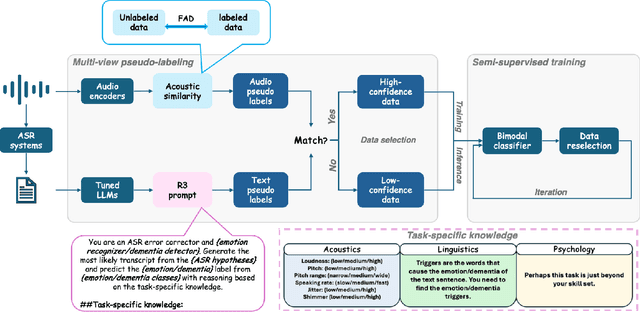
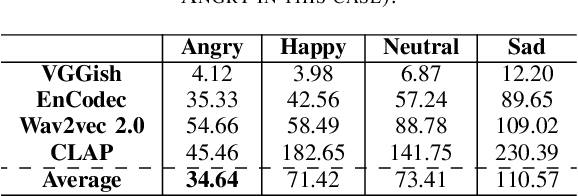

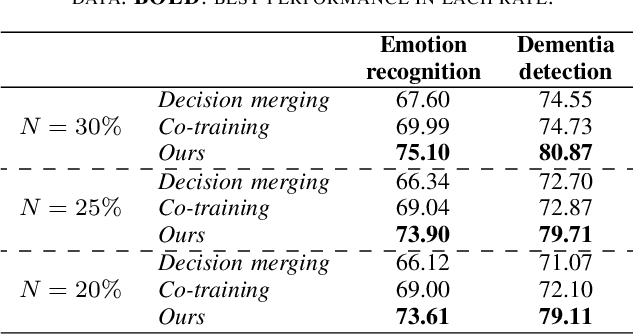
Abstract:The lack of labeled data is a common challenge in speech classification tasks, particularly those requiring extensive subjective assessment, such as cognitive state classification. In this work, we propose a Semi-Supervised Learning (SSL) framework, introducing a novel multi-view pseudo-labeling method that leverages both acoustic and linguistic characteristics to select the most confident data for training the classification model. Acoustically, unlabeled data are compared to labeled data using the Frechet audio distance, calculated from embeddings generated by multiple audio encoders. Linguistically, large language models are prompted to revise automatic speech recognition transcriptions and predict labels based on our proposed task-specific knowledge. High-confidence data are identified when pseudo-labels from both sources align, while mismatches are treated as low-confidence data. A bimodal classifier is then trained to iteratively label the low-confidence data until a predefined criterion is met. We evaluate our SSL framework on emotion recognition and dementia detection tasks. Experimental results demonstrate that our method achieves competitive performance compared to fully supervised learning using only 30% of the labeled data and significantly outperforms two selected baselines.
DaRec: A Disentangled Alignment Framework for Large Language Model and Recommender System
Aug 15, 2024Abstract:Benefiting from the strong reasoning capabilities, Large language models (LLMs) have demonstrated remarkable performance in recommender systems. Various efforts have been made to distill knowledge from LLMs to enhance collaborative models, employing techniques like contrastive learning for representation alignment. In this work, we prove that directly aligning the representations of LLMs and collaborative models is sub-optimal for enhancing downstream recommendation tasks performance, based on the information theorem. Consequently, the challenge of effectively aligning semantic representations between collaborative models and LLMs remains unresolved. Inspired by this viewpoint, we propose a novel plug-and-play alignment framework for LLMs and collaborative models. Specifically, we first disentangle the latent representations of both LLMs and collaborative models into specific and shared components via projection layers and representation regularization. Subsequently, we perform both global and local structure alignment on the shared representations to facilitate knowledge transfer. Additionally, we theoretically prove that the specific and shared representations contain more pertinent and less irrelevant information, which can enhance the effectiveness of downstream recommendation tasks. Extensive experimental results on benchmark datasets demonstrate that our method is superior to existing state-of-the-art algorithms.
Adaptive Speech Emotion Representation Learning Based On Dynamic Graph
May 07, 2024Abstract:Graph representation learning has become a hot research topic due to its powerful nonlinear fitting capability in extracting representative node embeddings. However, for sequential data such as speech signals, most traditional methods merely focus on the static graph created within a sequence, and largely overlook the intrinsic evolving patterns of these data. This may reduce the efficiency of graph representation learning for sequential data. For this reason, we propose an adaptive graph representation learning method based on dynamically evolved graphs, which are consecutively constructed on a series of subsequences segmented by a sliding window. In doing this, it is better to capture local and global context information within a long sequence. Moreover, we introduce a weighted approach to update the node representation rather than the conventional average one, where the weights are calculated by a novel matrix computation based on the degree of neighboring nodes. Finally, we construct a learnable graph convolutional layer that combines the graph structure loss and classification loss to optimize the graph structure. To verify the effectiveness of the proposed method, we conducted experiments for speech emotion recognition on the IEMOCAP and RAVDESS datasets. Experimental results show that the proposed method outperforms the latest (non-)graph-based models.
 Add to Chrome
Add to Chrome Add to Firefox
Add to Firefox Add to Edge
Add to Edge